
Website owner: James Miller
Streamline flow. Equation of continuity. Bernoulli’s Theorem. Venturi tube. Torricelli’s theorem. Viscosity. Reynolds number.

Streamline flow. The motion of fluids can be very complex and difficult to analyze. The turbulent flow of a mountain stream or the complicated air movements of the atmosphere are examples of this. However, there is an important type of fluid flow that is relatively simple. It is the smooth, steady, non-turbulent flow of a fluid through a tube called streamline flow or laminar flow. See Fig. 1. The flow of fluid in a tube is of the streamline type if the velocity is not too great and there are not bends or changes in diameter so abrupt as to cause turbulence. With streamline flow the path of any particle of fluid as it moves through the tube is called a streamline. One can map the flow of fluid through a tube by drawing a number of streamlines following the paths of the particles of the liquid. The rate of flow can be represented by the density of the streamlines. In streamline flow the velocity of the fluid at any chosen point within the tube is always the same.
Rate of flow of a fluid in a pipe. The rate of flow of a fluid in a pipe is given by
R = Av
where A is the cross section area and v is the velocity of the fluid.
Example. A fluid is flowing at a velocity of 5 ft/sec in a pipe with a cross section area of 2 ft2. Its rate of flow is then 10 ft3/sec.
The equation of continuity. In steady state flow of an incompressible fluid through a tube of varying cross section area
A1v1 = A2v2

where v1, v2 are respectively the velocities of the fluid at cross sections A1, A2.
Derivation. Consider the fluid flow shown in Fig. 2 where the cross-section area at point 1 is A1 and at point 2 is A2. In time t, the fluid at point 1 will advance a distance of d1 = v1t and a volume of liquid equal to A1d1 = A1v1t will pass point 1. Similarly, the volume of fluid passing point 2 in time t will be A2v2t. The volume of fluid passing points 1 and 2 in time t must be equal so
A1v1t = A2v2t
and
A1v1 = A2v2
which is the equation of continuity for the steady flow of an incompressible liquid.
Bernoulli’s Theorem. Bernoulli’s theorem states a relationship between pressure, velocity and elevation at points along a flowing stream of fluid . Given: steady, streamline flow of an incompressible, nonviscous fluid in a tube of varying diameter. Then for any two points along the flow
p + ρgh + ½ ρv2 = constant
where ρ is the density of the fluid and p, v and h are the pressure, velocity and height (i.e. elevation) at any chosen point in the stream.
In words, the theorem states that at any two points along the stream the sum of the pressure (p), the potential energy of a unit volume of the fluid (ρgh) and the kinetic energy of a unit volume of the fluid (½ ρv2 ) has the same value.
Bernoulli’s equation assumes streamline frictionless flow. If the tube is smooth, large in diameter, short in length and if the fluid has a small viscosity and flows slowly, the frictional resistance may be small enough to neglect.
______________________________________________________
Proof. Fig. 3 represents a section of a tube in which an incompressible, nonviscous fluid is flowing with streamline flow. The wide part of the tube has a cross section area A1 and the narrow part has a cross section area A2. At all points in the wide part the pressure is p1 and the velocity is v1. At all points in the narrow part the pressure is p2 and the velocity is v2.
As the fluid (shown in color) is being pushed to the right by a force equal to p1A1 through a distance d1, work is done on the system.
Work done on the system = p1A1d1
At the same time, the right end advances a distance d2 against an external force p2A2 acting in the opposite direction. Work is thus done by the system.

Work done by the system = p2A2d2
To move the system from Position 1 to Position 2, a net amount of work must be done by some agent (a pump, in this case) equal to
1) Net work done on the system = p1A1d1 - p2A2d2
Now the volumes A1d1 and A2d2 must be equal. Denote their volumes by V i.e.
V = p1A1 = p2A2
The mass m of the fluid in sections A1d1 and A2d2 is given by ρV where ρ is the density of the fluid. Thus
p1A1 = p2A2 = m/ρ
Consequently, from 1),
![]()
There is a net change in kinetic energy that occurs. It is given by
Net change in kinetic energy = ½ mv22 - ½ mv12
In the figure, the tube is horizontal and there is no change in gravitational potential energy. However, in the general case, the section A2d2 on the right side may be at a different elevation than the section A1d1 on the left side and the net change in gravitational potential energy is given by
Net change in gravitational potential energy = mgh2 - mgh1
where h2 and h1 are the respective elevations of the sections A2d2 and A1d1 above some arbitrary reference point.
The net work done on the system is equal to the sum of the increases in the kinetic energy and the gravitational potential energy. Thus

Multiplying by ρ/m we obtain
p1 + ρgh1 + ½ ρv12 = p2 + ρgh2 + ½ ρv22
or
p + ρgh + ½ ρv2 = constant
______________________________________________________
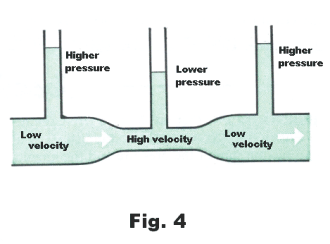
The Venturi tube. A Venturi tube consists of a tube with a narrow, constricted area as shown in Fig. 4. Because the fluid flows more rapidly through the constricted part of the tube, the pressure there is less, in accordance with Bernoulli’s theorem. This idea find application in many devices.
Torricelli’s theorem. The velocity v of outflow of a liquid from an orifice in a tank is
![]()
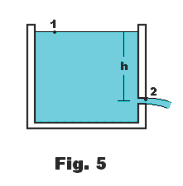
where h is the depth of the orifice below the surface of the liquid as shown in Fig. 5.
Note that the velocity of outflow is the same as that which would be acquired by a body freely falling from rest through a distance h.
_______________________________
Derivation. We apply Bernoulli’s equation to points 1 at the surface and 2 at the orifice as shown in the figure. We choose as reference level for the measurement of potential energy the height of the orifice. The pressure at both points 1 and 2 is the atmospheric pressure patm since both are open to the atmosphere. If the orifice is small, the level of the liquid in the tank will fall very slowly and we will assume it to be zero i.e. v1 = 0. Bernoulli’s equation then becomes
patm + ρgh + 0 = patm + 0 + ½ ρv2
or
![]()
_______________________________
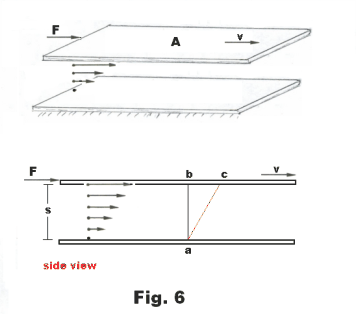
Laminar flow of liquids and viscosity. In the laminar flow of liquids the liquid can be conceived of as consisting of thin lamina or sheets that slide over each other in a similar way to the way in which the leaves of a book will slide over each other if we lay the book on a table and apply a horizontal force to the top cover. In Fig. 6 are two plates with liquid between them. The bottom plate is fixed and the top plate is moving to the right with a velocity v. The layer of liquid next to the top plate will move to the right with a velocity v, the same velocity as the plate. The layer of liquid next to the bottom plate will be at rest. The velocities of the intermediate layers will increase uniformly from the bottom plate to the top as shown in the figure. The cross section ab of liquid (shown in the bottom view) will, a moment later, assume the position ac.
It has been found experimentally that the force F required to keep the moving plate moving at a constant velocity v is directly proportional to the velocity v, inversely proportional to the separation s of the plates, and directly proportional to the area A of the moving plate i.e.
![]()
where η is the coefficient of viscosity.
The coefficient of viscosity, or simply viscosity, is small for liquids that flow readily, as water,
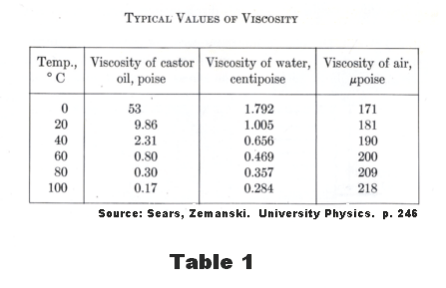
and large for highly viscous liquids such as molasses. It can be viewed as a measure of the amount of internal friction between layers of a fluid. It varies considerably with temperature. In the case of liquids it generally decreases with increasing temperature. In the case of gases it generally increases with increasing temperature.
The unit of viscosity is force times distance divided by area times velocity. In the cgs system a coefficient of viscosity of 1 dyne∙sec/cm2 is called a poise. Small viscosities are usually expressed in centipoises (1 cp = 10-2 poise) or micropoises (1 μp = 10-6 poise).
Some typical values of viscosity are given in Table 1.
A common method of measuring viscosity utilizes a small container with a small orifice of specified dimensions in the bottom. A specified amount of liquid is poured in and the time required for the liquid to run out through the orifice is measured. The viscosity is then computed by an empirical formula.
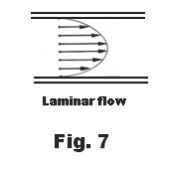
Fluid flow in a pipe. When the velocity of flow is not too large, the flow will be laminar. The laminar flow of a viscous fluid in a pipe will have a velocity profile of the shape shown in Fig. 7. The velocity is a maximum on the axis of the pipe and decreases to zero at the wall. There is a stagnant film of fluid at the wall called the boundary layer.
When the velocity exceeds a certain critical value, the nature of the flow changes and becomes far more complicated. Local circular currents called vortices develop throughout the liquid with a large increase in the resistance to flow. This type of flow is called turbulent flow.
Reynolds number. Reynolds number is a number that is useful in predicting whether flow will be laminar or turbulent. Reynolds number is given by the formula

where ρ is the density of the fluid, v is the velocity of flow, η is the viscosity, and d is the diameter of the pipe. Experiments have shown that when the Reynolds number is less than 2000 the flow is always laminar and when it is above 3000 the flow is turbulent. The interval from 2000 to 3000 is a transition region in which the flow is unstable and may change from one type to the other.
References
Schaum. College Physics.
Sears, Zemansky. University Physics.
Semat, Katz. Physics.
Jesus Christ and His Teachings
Way of enlightenment, wisdom, and understanding
America, a corrupt, depraved, shameless country
On integrity and the lack of it
The test of a person's Christianity is what he is
Ninety five percent of the problems that most people have come from personal foolishness
Liberalism, socialism and the modern welfare state
The desire to harm, a motivation for conduct
On Self-sufficient Country Living, Homesteading
Topically Arranged Proverbs, Precepts, Quotations. Common Sayings. Poor Richard's Almanac.
Theory on the Formation of Character
People are like radio tuners --- they pick out and listen to one wavelength and ignore the rest
Cause of Character Traits --- According to Aristotle
We are what we eat --- living under the discipline of a diet
Avoiding problems and trouble in life
Role of habit in formation of character
Personal attributes of the true Christian
What determines a person's character?
Love of God and love of virtue are closely united
Intellectual disparities among people and the power in good habits
Tools of Satan. Tactics and Tricks used by the Devil.
The Natural Way -- The Unnatural Way
Wisdom, Reason and Virtue are closely related
Knowledge is one thing, wisdom is another
My views on Christianity in America
The most important thing in life is understanding
We are all examples --- for good or for bad
Television --- spiritual poison
The Prime Mover that decides "What We Are"
Where do our outlooks, attitudes and values come from?
Sin is serious business. The punishment for it is real. Hell is real.
Self-imposed discipline and regimentation
Achieving happiness in life --- a matter of the right strategies
Self-control, self-restraint, self-discipline basic to so much in life